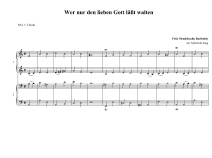This composition is taken from the so-called ‘chorale cantata’ Wer nur den lieben Gott lässt walten probably dating from 1829, the year in which Mendelssohn performed Bach’s Matthäus-Passion for the first time. Typically for the early Romantic period, the music refers to the past, through its use of lost or forgotten genres, composition techniques and traditions. The partita features a number of baroque characteristics:
a. The cantata genre; a form which had completely fallen out of favour in the early 19th century. (Mendelssohn would eventually compose eight such chorale-based cantatas).
b. The composition techniques associated with Bach are clearly present: the cantus firmus is heard in long notes surrounded by lively motifs, each line of the chorale is anticipated in the accompanying voices, and the text is evoked using rhetorical principles.
c. A preference for ‘old’ Lutheran chorales.
The work is divided into three sections:
Chorale: A sombre setting of the cantus firmus.
Variation: A lively movement, with the chorale melody heard in long notes, the style freely drawn from that of Bach.
Finale: A meditative, gently rocking soprano aria, related to the finale from the sixth organ sonata in d minor, op 65/6, MWV W 61.
Die Komposition ist der oft so genannten Choralkantate Wer nur den lieben Gott lässt walten, mutmaßlich aus dem Jahre 1829, entnommen worden, dem Jahr, in dem Mendelssohn am 11. März Bachs Matthäus-Passion der Vergessenheit entriss. Die sehnsüchtige Bestrebung, verlorene und vergessene Gattungen, Kompositionstechniken und Traditionen wieder zu beleben, der Hang zur Vergangenheit überhaupt, war bezeichnend für die Frühromantik. Auch dieses Werk weist verschiedene Barockmerkmale auf:
a. Die Kantatengattung, die im frühen neunzehnten Jahrhundert völlig aus der Mode gekommen ist, tritt wieder auf - Mendelssohn hat letzten Endes acht Choralkantaten komponiert.
b. Bachs Kompositionstechniken machen sich deutlich bemerkbar: Der Cantus firmus wird von lebhaften Motiven umspielt und erklingt in langen Notenwerten; die Choralzeilen sind mit Vorimitationen versehen, und Textvertonung erfolgt nach rhetorischen Prinzipien.
c. Lutherlieder werden bevorzugt.
Das Arrangement erklingt in drei Sätzen:
Choral: Ein schlichter Choralsatz.
Variation: Ein beschwingter Satz, in langen Notenwerten die Choralmelodie, frei im Sinne Bachs.
Finale: Eine meditative, leicht sich wiegende Sopranarie, die dem Finale der sechsten Orgelsonate d-Moll, Opus 65/6, MWV W 61, verwandt ist.
De compositie is ontleend aan het dikwijls als koraalcantate betitelde Wer nur den lieben Gott lässt walten en is waarschijnlijk geschreven in 1829, het jaar waarin Mendelssohn op 11 maart de Matthäus-Passion van Bach aan de vergetelheid ontrukte.Typerend voor de vroege Romantiek in het algemeen is de hang naar het verleden en het verlangen om verloren en vergeten genres, compositietechnieken en tradities te doen herleven. Ook dit werk heeft diverse barokke kenmerken:
a. het cantategenre; dat terugkeert nadat het in de vroege negentiende eeuw volstrekt uit de mode was geraakt (Mendelssohn componeert uiteindelijk acht koraalcantates);
b. Bach’s compositietechnieken zijn duidelijk aanwezig: omspeeld door levendige motieven klinkt de cantus firmus in lange noten, de koraalregels zijn van voorimitatie voorzien, en tekstverklanking vindt plaats vanuit retorische principes;
c. een voorkeur voor ‘oude’ lutherse koralen.
Het werk is driedelig:
Koraal: Een sobere zetting van het koraal.
Variatie: Een opgewekt deel, met de koraalmelodie in lange noten, vrij naar Bach.
Finale: Een meditatieve, licht wiegende sopraanaria, verwant aan de finale uit de zesde orgelsonate in d-klein, opus 65/6, MWV W 61.





